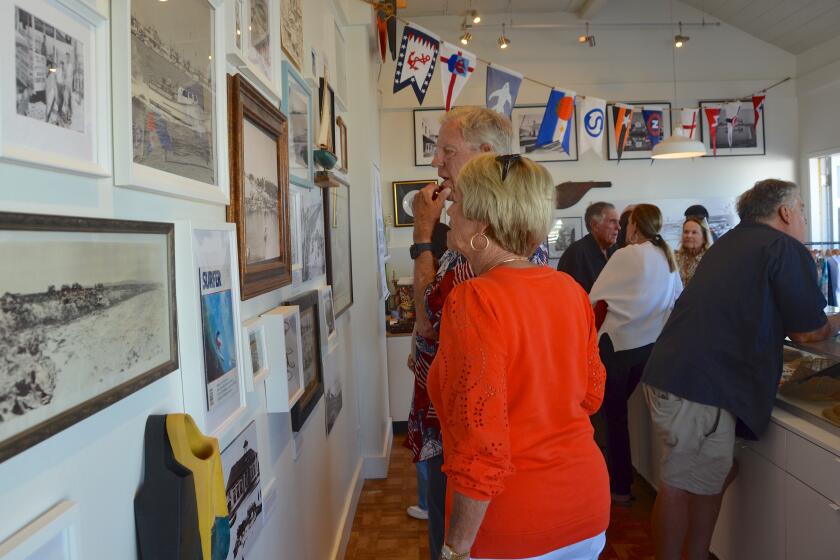A change of speed
MIKE WHITEHEAD
Ahoy.
I always find it comforting when I cross over the international
border back into U.S. waters when I am coming uphill aboard a yacht
from Mexico. This week I have crossed the border twice out in the
Pacific, once last Sunday and then again Wednesday. I traveled south
of the border twice to deliver both of these yachts to Newport
Harbor, and on both days I had a brief stop for U.S. Customs in San
Diego.
Sunday’s cruise up the coast was a little rough below the Coronado
Islands. In contrast, we found flat seas for Wednesday’s voyage. The
flat seas are great to run in, and you save traveling time with flat
seas.
A few factors contribute to saving time, but the primary factor is
that your overall traveling distance is less in flat seas. When
swells build, so does your overall traveling distance. You can
imagine a sine wave and how it curves up and down and up and down.
Try this experiment: First, cut a piece of string exactly 12
inches long and lay the string next to the ruler. Now, keep one end
of the string at the ruler’s zero mark and make uniform waves in the
string. Now, you will see that the 12-inch piece of string is
measuring less than 12 inches on the ruler, and the larger the curves
the less it extends on the ruler. Therefore, you now need a longer
piece of string with the waves to reach the ruler’s 12-inch mark.
Just as true, your travel distance on the water by boat will increase
as the swell heights increase, but the actual distance between the
two points remains the same.
Why is this important? Have you ever heard boaters who have made
that trip before and now they are out of fuel, or how about the
boater who arrives hours overdue? Sea conditions, wind conditions and
the speed over ground are all factors in planning your next voyage.
Keep in mind that speed through the water is not the same as speed
over ground.
Back to our 12-inch piece of string. If you are traveling at 12
inches per hour along the string, then in one hour you would travel
the length of the string. If the string is flat, then you will travel
12 inches along the ruler.
However, if the string has waves and ends at 8 inches, you will
travel an overall distance of only 8 inches in one hour. Cruising
along the string is comparable to speed through the water. In the
first scenario, when the string is flat, the speed through the water
and speed over ground will match, calculating to 12 inches per hour.
Not so in the second scenario. Your speed through the water (along
the string) is 12 inches per hour but your speed over ground (along
the ruler) is only 8 inches per hour. This means you will need 1 1/2
hours to travel the ruler distance of 12 inches.
Time for your test: Is the distance approximately 26.6 nautical
miles from the end of Newport Harbor jetties to Avalon Harbor on
Santa Catalina Island? The answer is yes because the actual distance
as the crow flies between the two points do not change. Only your
overall traveling distance through the water will change when the
swells increase in height.
Keep this experiment in mind for your next voyage, or at least be
sure to have paid your BoatUS/Vessel Assist membership.
TIP OF THE WEEK
Tonight is the Lido Isle Yacht Club’s Nautical Lecture Series
where I will be speaking about the importance of boating to the
Newport Harbor area. Plus, I will share some of my more memorable
cruising adventures along the Pacific coast. For more information
about this event, contact Dick Brown at (949) 675-5404.
Tune in to my “Boathouse Radio Show” every Saturday from noon to 1
p.m. on KCBQ-AM (1170). You can join in during the nation’s No. 1
boating talk radio show by calling the listener line at (888)
344-1170, and you can listen worldwide over the Internet at
https://www.boat houseradio.com.
Safe Voyages.
* MIKE WHITEHEAD is the Pilot’s boating and harbor columnist. Send
him your harbor and marine-related thoughts and story suggestions by
e-mail to mike@boathousetv.com or visit https://www.boathousetv.com.
All the latest on Orange County from Orange County.
Get our free TimesOC newsletter.
You may occasionally receive promotional content from the Daily Pilot.



